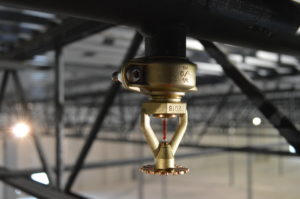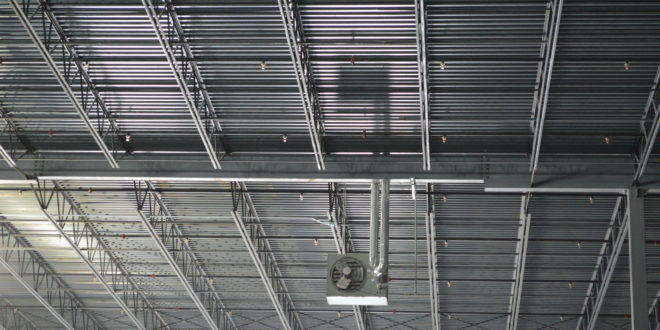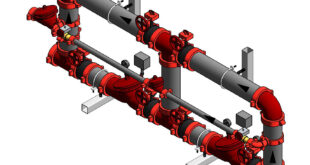Pre-assembled Couplings Reduce Installation Time
Warehouse and storage construction is changing in response to pressures exerted by the digital marketplace. Those same pressures are impacting fire sprinkler system design and installation.
The Digital World More and more people are using devices to do their shopping, and this shift toward digital purchasing is changing the way people live. According to Forrester, one of the world’s most influential research and advisory firms, the number of consumers browsing and buying online will hit 270 million by 2020, driven largely by activity on mobile devices.
In a move to satisfy buyers who want their purchases immediately, companies like Walmart are now offering two-day delivery, and Amazon, the world’s biggest retailer, has just introduced a new distribution scheme called Fulfillment by Amazon (FBA) to improve delivery service. The goal of FBA is to expedite the speed at which products reach customers by leveraging the company’s fulfillment centers to pick, pack, and ship products. To reach more people more quickly, FBA will require many more fulfillment centers, and many of these will use robots to fill orders.
Evolving Needs Today, companies like Amazon are looking closely at how they will have to offer customer support as well as merchandise from the FBA centers, which means offices will be housed jointly with storage and distribution services. And Amazon is not unique. Many companies are adjusting the way they move merchandise to customers, and that has changed not only how they are using warehouses, but how many warehouses they need and how these facilities will be operated.
Efficiently managing fluctuating capacity is another driver that is impacting warehouse usage, with more owners subletting space during off-peak periods to short-term lessees. According to a special report, “Multitenant Distribution Warehouse Segment in the U.S. Outlook 2016,” released by Cushman & Wakefield, a global real estate services firm, “healthy demand and tight supply has made multitenant distribution warehouses among the best performing of all commercial real estate segments.”
Flexibility is great for companies that need short-term access to warehouse space, but it is a challenge for builders, which historically have designed warehouses to fill more traditional roles. The pace at which new locations are needed and change in space usage is having an impact on design and construction, and sprinkler systems will be among the components that are affected.
Building warehouses for flexibility has not been the norm, but anticipated usage is changing the playing field. Soon, more facilities will house multiple tenants. Warehouses will have to be refashioned quickly when tenants and space usage change, and spatial planning support. Warehouse owners that want to capitalize on leasing opportunities will seek out both design and construction companies that can keep pace with the demand to redesign and reconfigure their warehouses, such as companies that embrace new product technologies that lend themselves to system adaptability and fast installation methods.
Evolution of Technology In order to support the changing needs of warehousing, new product development has been critical, ensuring economical installation and design. Product advancements in fire protection systems for warehousing have come in many forms, pipe joining, sprinkler technology, and even system valves have simplified with electrical alarms and detection.
In the mid-1970s, joining technologies advanced from welding, flange, and threading mains and branch lines to being able to make connections with a coupling, which engaged either a rolled (cold formed) or cut groove in the pipe ends. Today, roll groove technology is the primary connection method for 11/4-in. to 12-in. pipe in fire protection systems. This allowed sprinkler piping to be adjusted in the field with minimal time and effort compared to welding and threading. It also provided valuable union connections at each joint for adaptability.
While the connection and fabrication of the joint was much faster, these couplings needed to be disassembled before assembling onto the joint. Thirty years later a new design of coupling was introduced, where it was pre-assembled or “ready to install” straight out of the box. These did not require disassembly, encouraged impact guns for assembly, and since have become the standard in coupling technology for the industry.
As the world was developing higher storage buildings and the introduction of plastics in storage, fire sprinklers needed to also advance. FM Global was a leader in this field, as their vested interest of providing better fire protection options for their insurance clients, drove them to create a new type of sprinkler. Early suppression fast response (ESFR) sprinklers were developed in the late 1980s and saw introduction into the market shortly thereafter. Initially, these sprinklers allowed warehouses to store plastic components up to 25 feet in 30-ft buildings with ceiling-only sprinkler protection. Soon larger K-factors, K16.8, 22.4, and 25.2 were developed allowing greater building and storage heights. Today, ceiling-only sprinkler protection can protect buildings up to 48-ft ceiling height.

With the advancement in sprinkler and joining technologies, so too changed the way sprinkler piping was designed and fabricated. Grooving the pipe ends and fabricating different size threaded outlets directly to the branch line allowed for fast, clean installations. The challenge for this design in the current landscape was once the pipe was fabricated and installed, you had to either plug, cut or remove sections of pipe for changes. Standardizing on a one-outlet-size-fits-all approach addresses all of these concerns and redefines sprinkler installation regardless of the changing system requirements, and an outlet with the 1-in. Innovative Groove System (IGS) grooved profile does just that. The last piece is applying this groove to a sprinkler with a captured ready-to-install coupling, so transitions are easier than ever. (See Figure 2.)
As threading had been the standard way to connect many smaller sprinkler components, now it is possible to connect grooved sprinklers with pre-assembled couplings, standardizing on a 1-in. IGS grooved outlet to accommodate all connection possibilities. Adding reducing fittings (bushings) to install sprinklers added potentially costly leak points to the system. Similarly, sprinklers were only ever made with threads that needed some form of preparation before installation, until now.
The biggest time saver and labor-management advantage introduced into small pipe diameter sizes, such as 1 in., is the elimination of prep work and the associated consumables (tape and dope). Now, utilizing a mechanical connection with one-bolt allows the fitter to use a power tool to save both wear and tear on their body, and avoid applying torque directly to the sprinkler frame. Reducing torque applied to the sprinkler frame and replacing the frictional connection with a mechanical one, in turn, reduces the likelihood of leaks when the system is pressurized. Rework due to leaks can add an average of one day of labor per system. By eliminating taping and doping on the ground, all fitters can be utilized in the air hanging and installing system components.
Sensible Solutions By utilizing new technologies and making fire sprinkler systems more adaptable to the changing needs, there will be greater acceptance to ensuring the right sprinkler system design and installation matches the consumer’s needs.
ABOUT THE AUTHOR: Daniel Wake is product manager – sprinklers and devices for Victaulic and is celebrating 20 years in the industry. He began as an apprentice in 1998 and worked as a fitter in Australia and the U.S. for the next 12 years.Wake has been at Victaulic since 2010, as an application engineer; sprinkler specialist; and then product manager for sprinklers, devices, fire protection valves, and Victaulic’s Bermad line. He is a member of the NFPA 13 (SSI) and NFPA 120/122 committees, and is a Certified Fire Protection Specialist.
SIDEBAR: Reinstalling Grooved Sprinklers
by Roland Huggins, PE, AFSA Senior Vice President of Engineering & Technical Services
This article raises an interesting question for sprinklers with a grooved fitting. If you look at NFPA 25, Standard for the Inspection, Testing, and Maintenance of Water-Based Fire Protection Systems, it says when it’s been removed, it shall not be reinstalled. The 25 handbook then goes on to state: “Some installing contractors interpret this to mean that if the sprinkler drop assembly is removed without removing the sprinkler from the drop, it can be re-used.” The handbook then continues to say that this section and related sections of NFPA 13, Standard for the Installation of Sprinkler Systems, do not allow this. Unfortunately, this is blatantly wrong.
NFPA 13: A.6.2.1.1 explicitly states: “Sprinklers should be permitted to be reinstalled when the sprinkler being removed from the system remains attached to the original fitting or welded outlet, provided care has been taken to ensure the sprinkler has not been damaged.” The issue is once there has had torque applied to the sprinkler, it cannot be removed and used again such as for tenant improvements or testing (removal to check the inside of a branch line). The NFPA 13 handbook summarizes it very well by saying under section 6.2.1.1: ”It was further clarified in the 2016 edition that the restriction applies only to directly UNSCREWING the sprinkler from the fitting.” The fact that this applies to only threaded fittings wasn’t stated since that was the only type available. Now that we have a sprinkler connected using a mechanical fitting, there is no torque applied to the sprinkler to install or uninstall it. As such, it can be reused the same as allowed for relocating a sprinkler as part of a drop.
Since this has not yet been addressed by the technical committees, ensure you discuss it with the Authority Having Jurisdiction (AHJ). It’s also worth ensuring if they’ve read the NFPA 25 handbook that they realize that installation criteria is the purview of NFPA 13 and it supersedes NFPA 25 and its handbook.
IMPORTANT NOTICE: This sidebar and its content are not a Formal Interpretation issued pursuant to NFPA Regulations. Any opinion expressed is the personal opinion of the author and presenter and does not necessarily present the official position of the NFPA and its Technical Committee.
 Sprinkler Age A Publication of the American Fire Sprinkler Association
Sprinkler Age A Publication of the American Fire Sprinkler Association


